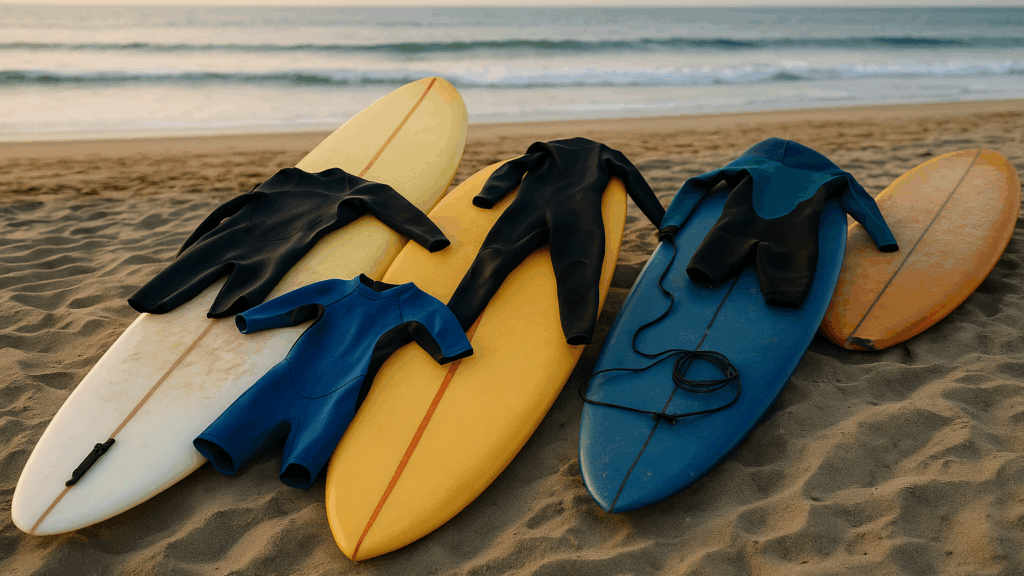Now Reading: Buying a used board like a total pro
-
01
Buying a used board like a total pro
Buying a used board like a total pro
You’re ready to graduate from your borrowed Costco foamie, and someone on Facebook Marketplace is selling a “lightly used” board for $150. Great deal, right? Let’s find out.
Buying second-hand can save you hundreds of dollars, but it’s terribly easy to buy a total dud if you don’t know what to look for.
So this is your ultimate guide to buying a second-hand surfboard like a pro, including what to check, what to avoid, and a dedicated section on foam boards (because yes—they have their own red flags).
🧐 First, know what you need
Before you even browse the FB Marketplace, know for sure:
- What size/shape/volume are you looking for?
- What’s your level?
- What kind of waves are you surfing?
Don’t get seduced by a good price on a board that’s totally wrong for you. It happens all too often. Like ALL THE TIME. Do not do it!
🚨 Let’s talk about the absolute no-nos:
- Delamination (delam): Soft, bubbly spots where the fiberglass separates from the foam.
- Buckling: Long, thin creases across the deck—often a sign of the board being close to snapping.
- Water damage: Yellow or brown discoloration (especially in spots) = water’s gotten in.
- Snapped and repaired: Avoid unless you’re buying a wall decoration.
- Covered in art to hide any bad repairs. Yeah, some people are assholes.
- Evident, gigantic holes that make you ask: did you go to the shop and price the repair already and it’s just not worth repairing? Again, some people…
And this is what a full inspection like a pro should look like, step by step:
Pricing Tips:
- Check for pressure dings, they are normal. These are those small dents on the deck from feet/knees. Totally fine unless they’re super deep or forming around the stringer like a trench.
- But delam is bad. Press on the deck and bottom with your palm. If it’s squishy or air-pockety = delam = walk away.
- Water damage is the biggest no-no. If you see any brown spots or circular yellow stains, this means it got wet inside—usually due to an open ding left unsealed. It makes the board heavier and harder to surf. You do not want that.
- About those cracks & dings: Minor dings are common—but they must be repaired properly. Feel with your fingers. If your nail catches in a crack, water will too. Beware the paint cover-up. Paint jobs, Posca pens, or full wraps might be hiding damage.
- If you see previous repairs, they are not a dealbreaker if done well: clean, sealed, dry. Poor repairs = water inside, risk of delam, and resale value tanked.
- Check fin boxes for cracks around them. Wiggle fins to test stability. Non-standard fin systems = hard to find replacements (avoid unless you’re into that sort of thing).
- When checking a leash plug: Make sure there are no cracks. No wiggling. Solid as a rock.
- Oh, the wax job. That should’ve been #1. A lot can hide under a layer of wax, so ask the seller to remove the wax before you inspect.
- You can 🔦 use your phone light to have a closer look. Shine your phone light across the rails and deck to spot cracks, repairs, warps, and hidden soft spots.
- Better still, take a mate with you. So you can talk about the board. Loudly.
🤑 A few pricing tips
You are a smart cookie, you already know this.
- If a board is suspiciously cheap, assume something’s wrong.
- If it has tons of dings or a weird repair? Lowball or walk away.
- Compare the used price to what it would cost new (don’t overpay for junk).
- Always haggle!
🚩 What to look for in a used foamie
Not tons of differences, but still worth mentioning a few. Let me sail through this quickly, because these babies get funky fast.
🪜 Surface cleanliness
Foam boards absorb everything—grime, wax, sunscreen. Human skin…LOL. Dirty is fine. Mold? Gross, but not fatal.
💧 Waterlogging
Heaviness is your clue, a soaked foamie will feel like it weighs 20 pounds. So, knock gently—if it sounds dull or wet inside, pass.
🔩 Fin boxes & leash plug
If they’re pulling away from the board or feel soft = no good. Some foamies have glued-on fins—check for wobble or cracking around the base.
Delam & bubbling
Foamies can delam too. My Wavestorm looks like a food wrap is coming off it. My fault—left it in the sun for far too long. Any bubbling, and it’s bye bye birdie.
🪑 Spongey deck
All foamies dent a bit—but check that it’s not soft or sagging in weird areas.
🚩 Red flags for foam boards
- Giant gouges or open foam
- Any drag (flattened tail or squashed nose)
- Warping or twisting
- Bottom slick peeling away
- Giant soft spots under the chest area
- If it smells weird—it’s been sitting too long.
🧱 Foamie bonus tips
Ask for the make/model. Google it—some foamies aren’t worth $20 used. Check surf school sales. They’re rough-looking but often still solid.
🛒 Final buyer etiquette
Be a gracious and detail-oriented potential buyer.
- Inspect in daylight.
- Bring a towel (to lay it down safely).
- Don’t feel rushed. A 5-minute inspection can save you $300 in repairs.
- Lowball respectfully—especially if repairs are needed.
- Walk away if the seller seems sketchy or pushy.
Buying second-hand can be a smart move—but surfboards aren’t like bikes or guitars. They’re watercraft, and water gets in everywhere if things go wrong.
So go in with your eyes open, your fingernails ready to feel for cracks, and your BS radar on. If it feels off—it probably is.






















